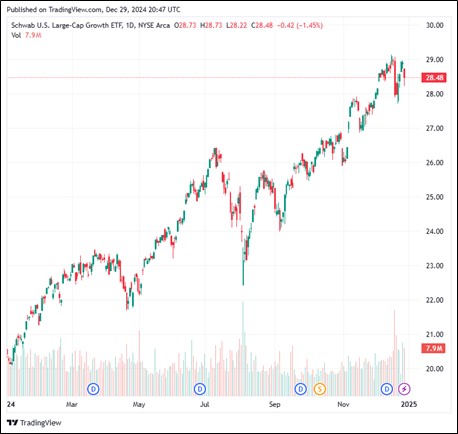How Does 37% Sound?

Image: The Schwab U.S. Large Cap Growth ETF (SCHG) is up more than 37% so far in 2024.
By Brian Nelson, CFA
How does 37% sound? That was the price-only performance of the Schwab U.S. Large Cap Growth ETF (SCHG) thus far in 2024. Over the preceding 5-year period, the SCHG is up over 140%.
For years, I have pounded the table on the theory that there are not value or growth stocks, but rather undervalued, fairly valued, or overvalued stocks. It’s why many growth stocks can be undervalued. It’s the Theory of Universal Valuation found in Value Trap that ties myriad areas of finance to the well-known discounted cash-flow [DCF] model. Growth is a component of value. Hook, line, and sinker.
For years, I have been pounding the table on large cap growth as my favorite area for idea generation (given its Valuentum stock tendencies), and I have put my money where my mouth is, too, with a meaningful portion of my net worth in SCHG. You’ll find that a lot of the top holdings in SCHG are top considerations in the Best Ideas Newsletter portfolio, too, so there’s some good overlap between what I consider Valuentum stocks and where I’m putting my money.
But why don’t I actually own all the stocks I like? It’s the question I have been asked for more than a decade. Here’s what I wrote back in September 2023. I’m an old school analyst that cut my teeth in this business following the Global Analyst Settlement, meaning I believe that writers should generally not be taking stakes in the individual stocks they write about. Writers with positions in the stocks they write about can lead to biased research, or worse, terrible outcomes.
So what’s the playbook for 2025? You can probably guess that I think large cap growth and big cap tech will continue to lead the markets to new heights. 2024 was a boring year, if a 37% return can be considered boring for large cap growth. Frankly, with the market focusing on macro data and the Fed during 2024, there wasn’t much material to write about. We all already know the story: Inflation is under control, the job market remains healthy, the Fed is cutting, and artificial intelligence will be the name of the game this decade.
I think it’s worth clarifying some of our offerings every now and then, as each one focuses on a unique vertical. For those seeking capital appreciation, the Best Ideas Newsletter portfolio may be of interest. For those seeking dividend growth, the Dividend Growth Newsletter portfolio includes our favorite ideas, while for those seeking high yield, the High Yield Dividend Newsletter may be your cup of tea. Dividend growth focuses on dividend growth potential; high yield focuses on current high yield, and so on and so forth.
The Exclusive publication is one of my favorite publications, where we highlight an income idea, a capital appreciation idea and a short idea consideration each month. You can read more about the Exclusive publication here. As of the date of the release of the December edition of the Exclusive publication, success rates for Capital Appreciation Ideas were 90.1%, while success rates for Short Idea Considerations were 88.1%. If you haven’t yet tried out the Exclusive, please do so.
Okay – so what about dividends? Unfortunately, I think we’re in for another difficult year for dividend growth investing. The SPDR S&P Dividend ETF (SDY) is only up 6% year-to-date, trailing both the equal-weight and market-cap weighted S&P 500 indices by sizable margins. With the 10-year Treasury yield at 4.6% and certificate-of-deposit rates still elevated, dividend-only-focused investors will likely continue to trail the broader markets. Remember: dividends are capital appreciation that otherwise would have been achieved, so don’t let the dividend tail wag the total return dog.
What about Bitcoin? I really don’t know. It’s definitely a greater fool asset like gold, but I have totally underestimated the number of fools there are these days. Haha. Just kidding, but seriously, with the regulatory environment easing with respect to crypto and with President-elect Donald Trump supporting crypto assets, who really knows how high Bitcoin can get or just how volatile the asset may become as institutional money ebbs and flows.
So what about small cap value? Well, year-to-date, the iShares Russell 2000 Value ETF (IWN) is up a meager 6%, and it is up just 28% over the past 5 years, trailing large cap growth considerably. With a near 30% weighting in financials and 10% weighting in real estate in the IWN, for me, it’s a no-brainer to avoid. The only way I believe the gap between large cap growth and small cap value narrows is if large cap growth falls on difficult times, which can never be ruled out. But that said, there’s no reason to believe in the IWN, no matter what the statisticians say about quantitative value. I tackle the issue of the pitfalls of falling in love with historical data in Value Trap, too.
All things considered, 2024 was an absolutely amazing year for our core research exposure (i.e. large cap growth). Do I think the SCHG will repeat its dazzling performance in 2025? Probably not to the same extent, but it’s hard to bet against some of the strongest net-cash-rich, free-cash-flow generating powerhouses on the market today. Give me Apple (AAPL), Nvidia (NVDA), Microsoft (MSFT), Amazon (AMZN), Alphabet (GOOG) any day of the week, especially over any financials-heavy index. Enjoy the rest of 2024 folks!
-----

Brian Nelson owns shares in SPY, SCHG, QQQ, DIA, VOT, RSP, and IWM. Valuentum owns SPY, SCHG, QQQ, VOO, and DIA. Brian Nelson's household owns shares in HON, DIS, HAS, NKE, DIA, RSP, SCHG, QQQ, and VOO. Some of the other securities written about in this article may be included in Valuentum's simulated newsletter portfolios. Contact Valuentum for more information about its editorial policies.
Valuentum members have access to our 16-page stock reports, Valuentum Buying Index ratings, Dividend Cushion ratios, fair value estimates and ranges, dividend reports and more. Not a member? Subscribe today. The first 14 days are free.
0 Comments Posted Leave a comment